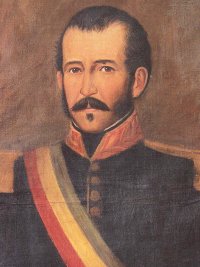Peruvian–Bolivian War of 1828
The various pro-independence currents were confronted: the increasingly weak San Martín monarchism, the plebeian, liberal and parliamentary republicanism (José Faustino Sánchez Carrión, Francisco Javier Mariátegui y Tellería and Francisco Xavier de Luna Pizarro), the nationalist and militarist republicanism led by Riva Agüero and the Bolivarian confederation project.
Previously, the Aid Agreement was signed on March 18 between Juan Paz del Castillo and Mariano Portocarrero, establishing that Colombia will help Peru with 6,000 soldiers and they will be in command of Sucre until Bolívar's arrival.
[7] On June 23, Congress deposed and banned Riva Agüero, who fled to Trujillo with his supporters, leaving power to Sucre and the new president, José Bernardo de Tagle.
The conflict finally ended when Riva Agüero was captured in Trujillo by Colonel Antonio Gutiérrez de la Fuente's cuirassier regiment on November 25.
[9][10] With a strong anti-Napoleonic propaganda in Peru, sending money and reinforcements to its allies, expeditions were able to be armed that allowed to recover the old viceregal territories.
Abascal's policy of territorial recovery and turning Peru into the symbolic and material center of the South American counterrevolution, was only possible thanks to the coincidence of interests between the Spanish authority and the Peruvian aristocracy.
One of the reasons that Riva Agüero dispatched the Santa Cruz expedition before Bolivar arrived was to ensure Peruvian sovereignty in Charcas, as he correctly assumed that Colombians did not look favorably on an overly powerful Peru.
[7] Sucre was accused of wanting to divide Peru for allowing this to happen and controversy continued to arise, and in the end the country was left independent in order to serve as a role model not only for Bolivar's planned confederation, but for other soon-to-be states, such as Ecuador.
The Bolivians also claimed Arica, the port where they exported their wealth, but they were forced to stay with Cobija, since Bolívar did not want to provoke the people of Lima any further.
[9] Legal workarounds were unsuccessfully worked on by the newly formed Bolivian nation, and this desire to gain the Arican port later manifested itself in its support and active efforts to realize the Peru–Bolivian Confederation.
On the early mornings of April 18, 1828, Sucre was informed at the National Palace that the Colombian soldiers of the Voltígeros battalion had risen up in the La Guardia barracks.
[13] The president sent Colonel José Escolástico Andrade to control the situation, and shortly after he personally attended in the company of his aides, Minister Infante and Colombian captain Cipriano Escalona.
What do you want?Before finishing the sentence, however, three closed volleys by order of Sergeant Guillermo Cainzo from Tucumán pierced his hat, superficially wounded him on the forehead and right arm, while Escalona was hit in the left.
He ordered General Blas Cerdeña to send the vanguard of sappers at the river crossing and that a reserve be in charge of Manuel Martínez de Aparicio.
[15] At that time, the insurgents of Chuquisaca had proclaimed Dr. José Antonio Abencey as president, and Gamarra recognized him and affirmed to invade with his authorization given in a letter of April 20.
[15] He also sent letters to Sucre offering to preserve order, inviting him to national reconciliation and promising that his troops would never attempt against the life of the victor of Ayacucho.
[15] This is an internal revolution and to put down it I have enough strength, but I prefer to give my neck to the blade of my murderers, rather than agree that the principle of intervention is sanctioned in America[16]The La Mar government did nothing to arrest its general because: [...] the tone of Peruvian politics was one of accentuated anti-Colombianism.
On the 22nd, the captain of the Dragones de Montenegro charged against a party of 32 Bolivians and captured 29, including Lieutenant Mota, who was slightly wounded and brought before Gamarra, who freed him and his soldiers.
On the 26th Colonel Ramón González, the commander of Cazadores Manuel Valdez (chiefs of the 1st and 2nd battalions of Bolivia respectively) and artillery captain Narciso Núñez attempted a mutiny in Paria but were surprised before carrying it out.
Shortly before, Braun tried again to resist, this time in Oruro he managed to force the Zepita battalion to withdraw without suffering casualties from the bulk of the Peruvian army.
[15] Pérez de Urdininea addressed a proclamation to the Bolivians and another to the soldiers, congratulating them on their independence and defending that the Treaty of Piquiza had been signed to avoid a civil war.
On August 2, Sucre gave his last speech before Congress in Chuquisaca, but no one appeared; The same thing happened the next day and so he understood that everyone was waiting for him to leave to start sessions.
He commissioned Deputy Mariano Calvimonte to read his speech, which included his resignation, ideas on how to organize the government, and a three-person roster for the position of vice president.
[15][7] Gamarra, promoted to Grand Marshal by the treaty, sent 10,000 pesos to Braun for the troops to leave and commissioned General Martínez de Aparicio to watch over their march.
[7] On September 3, Gamarra said goodbye to the Minister of Foreign Affairs, and on the 8th of the same month he declared that Bolivia was free to establish itself and that the National Assembly was in charge of governing its destinies.
[15] In his farewell proclamation to the Bolivian people, Gamarra expressed: [...] that the troops who had come to restore their rights were leaving without having broken their word and promises [...] [the republic of] Bolívar already has its own existence, its fate remains in the hands of its children.
Because of Gamarra's non-intervention policy in Bolivia, Blanco Soto and Loayza Pacheco revolted in September 1828, with the latter declaring the independence of the La Paz Department under the name of the Republic of Upper Peru.

